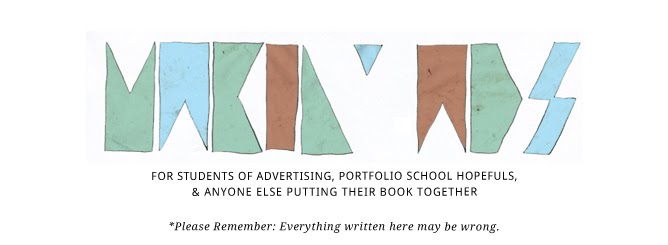This article was written for
one.a magazine by one of my
favorite copywriters. The article is about a decade old, and the advice is even older. And it still applies to you and me today. Enjoy.
The Agency With
the Best Softball Team
Does the Worst Creative
By Sally Hogshead
I heard this one in the hallway. It was late, around 11 pm. We were in a pitch against an agency with an exceptionally good softball team.
I’ve learned a lot in agency hallways, bits of wisdom mentioned in passing while eating microwave popcorn. (This is especially true when you’re sharing the popcorn with Luke Sullivan or Jean Robaire.) Here are some of the more memorable words of advice I’ve heard, standing in line for the copier.
When pursuing a job, don’t send a fake foot to “get your foot in the door.”
Secretaries know more about what’s going on than we do.
It doesn’t necessarily matter if people say they don’t like an ad you’re working on. But think carefully if they say they don’t get it.
The wacky creative with noserings rarely does the coolest ads.
Brilliant ideas are fragile. They won’t get produced unless everyone in the agency is dedicated to helping them through.
The small space magazine category in the One Show has the least entries.
There are 5 elements to an ad. Headline, visual, body copy, logo, tagline. The more elements you can get rid of, the better the ad will be.
Warning: everyone’s seen too many fake warning labels.
Which agency you work for usually matters less than which accounts and creative director you work for.
It usually takes a hundred headlines to come up with one great one.
When a prospective employer makes all sorts of promises, remember that your salary agreement is the only promise they can’t flake out on.
That being said, don’t go for the money.
Most creatives can come up with a great idea. But the really successful ones keep coming up with them, over and over, as often as the client kills them.
Shock value only works if it’s tied to the product benefit.
In general, layouts look better when designed on paper first.
Don’t take anything into a presentation you wouldn’t want to produce. If we don’t present bad ads, we won’t do bad ads.
Concepts we’ve all used (proof of our collective unconscious?): Fake classifieds and Help Wanted ads... bugs smacking into windshields... Just Do It parodies... far-fetched comparisons to ancient cultures... fingerprints... long lines of people waiting to use a single public phone... anything to do with condoms or S & M.
Advertising people are the last great folk artists. Everything we do is anonymous, disposable, and useful.
Resist the urge to explain ads while someone’s looking at your portfolio.
A rule of thumb: The most interesting part of a headline goes at the end.
There’s an enormous difference between A- and A+.
It’s usually obvious in the first couple of weeks whether a new job is going to work out. Don’t wait around too long, hoping things will get better.
Donate your copy of Ogilvy on Advertising to Goodwill.
It’s almost always less expensive to give a creative more money than to try and replace him.
Don’t work for someone whose taste you don't respect.
Gangbangs ruin morale.
Agencies do not “turn themselves around.” The kind of work an agency does is an integral part of their culture. A freshly painted lobby, a big motivational speech, a new creative director can only do so much.
Scientific research has proven that good visual thinkers are bad spellers.
Repay the favor that someone once did for you. Meet with a junior.
Okay, we’ve all done it. But if you do an ad for a “freebie” client, it’s better to find something that sounds legit, instead of a veterinary acupuncturist.
Bill Westbrook’s concepting timeline: First, creatives come up with every pun and easy joke and really they have nothing. Second, they realize they have nothing and feel like hacks. Third, epiphany, a good idea.
Great radio spots are engaging within the first five seconds.
Politics happen when employees feel like they can’t let their work speak for itself.
Seek out the hidden emotions or insecurities that most people have, and few admit to.
So few people in this business use common courtesy. It’s always appreciated and remembered.
Smart beats clever.
When an agency is not totally committed to doing killer work, even talented and ambitious creatives have a tough time producing killer work.
Trust your gut, it’s smarter than you are.
Creatives usually come up with better work on the second or third rounds. (Don’t tell clients.)
Finally, we’re not all starting headlines with “finally.” Other headline formats to use with caution:
Think of it as a _(clever noun) .
If _(person or thing)_ had a __(noun)_ , this would be it.
It's like a _(noun) for your (noun) .
While we’re on the subject, fonts to consider packing away along with collarless shirts and Adam Ant CDs:
Caslon Openface
Remedy
Tekton
Crackhouse
And the other trendy grungy fonts. (Yes, I know this one’s difficult, but it’s time. Let it go.)
Being a good partner is half of being a good creative.
It wasn’t any easier in the good ol’ days.
An agency’s quality of life is usually inversely proportional to the quality of work it does. Unfortunately.
The kid who’s book you crap on could be interviewing you one day. Go easy.
Sooner or later, people end up where they belong.
Send more thank-you notes.
Pick out a last name that people can make fun of.




